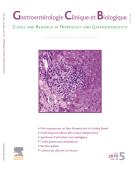Quel traitement peut-on proposer après un échec d'éradication de Helicobacter pylori ? - 29/02/08
Stanislas BRULEY DES VARANNES
Mostrare le affiliazioniL'échec d'éradication d' H. pylori concerne généralement entre 10 et 30 % des patients. En pratique clinique, face à un échec d'éradication, il est nécessaire a) d'identifier les causes potentielles, b) de confirmer l'intérêt de l'éradication, et c) de choisir une stratégie thérapeutique de seconde ligne. Parmi les facteurs plus fréquemment associés à un échec d'éradication, on note une médiocre compliance, le relativement jeune âge, le tabagisme, une inflammation antrale faible. Le facteur principal de résistance est avant tout lié à la sensibilité de la souche bactérienne aux antibiotiques utilisés. En France, la résistance à la clarithromycine se situe aux alentours de 10-15 % et la résistance au métronidazole aux alentours de 30 %. Pour réduire l'induction de résistances, il est déconseillé d'associer en première ligne la clarithromycine et le métronidazole. En règle générale, le traitement de première ligne doit suivre les recommandations officielles (inhibiteur de la pompe à protons (IPP)-amoxicilline et clarithromycine). En cas d'échec, le traitement de seconde ligne fait appel à une trithérapie qui, compte tenu du faible taux de résistance à l'amoxicilline, va associer un IPP à double dose, l'amoxicilline et l'antibiotique non utilisé lors du traitement de première ligne (métronidazole lorsque la clarithromycine a été initialement utilisée et inversement). Cette approche permet d'éradiquer entre 50 et 80 % des patients en échec antérieurement. Un nouvel échec doit faire pratiquer une culture avec étude de la sensibilité du germe. Le traitement devra alors associer à l'IPP les antibiotiques auxquels la souche est sensible, sur une durée plus longue. Dans certains cas, d'autres antibiotiques efficaces dans ces circonstances, comme la rifabutine, peuvent éventuellement être utilisés.
How to treat after Helicobacter pylori eradication failure? |
Helicobacter pylori eradication failure generally concerns between 10 and 30% of the patients. When eradication failure occurs, it is necessary a) to try to identify the potential causes, b) to confirm the indication of eradicating H. pylori, and c) to choose a second line therapeutic strategy. Among the factors most frequently associated with failed eradication, are poor compliance, younger age, smoking, and weak gastric inflammatory activity. The major factor of resistance is related to the sensitivity of the bacterial strain to antibiotics used. In France, resistance to clarithromycin is around 10-15% and resistance to metronidazole around 30%. In order to limit development of resistance, it seems preferable to avoid associating clarithromycin and metronidazole in the first line treatment. At best, the first line treatment must follow the official recommendations (PPI-amoxicillin and clarithromycin). In the event of eradication failure, second line treatment calls upon tritherapy which, due to the low rate of resistance to amoxicillin, associates double-dose PPI, amoxicillin and the antibiotic not used during the first line treatment (metronidazole if clarithromycin was initially used and conversely). This approach allows to eradicate between 50 and 80% of the first-line failure patients. In case of further failure a culture with measurement of the strain sensitivity is required. Subsequent treatment associates PPI with the antibiotics to which the strain is sensitive for a longer duration. In some cases, other effective antibiotics, such as rifabutin, might be used in these circumstances.
Mappa
© 2003 Elsevier Masson SAS. Tous droits réservés.
Vol 27 - N° 3-C2
P. 478-483 - Marzo 2003 Ritorno al numeroBenvenuto su EM|consulte, il riferimento dei professionisti della salute.

